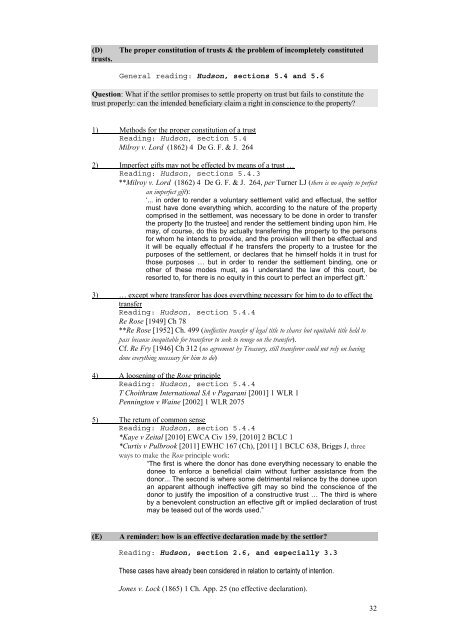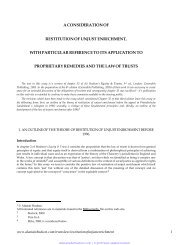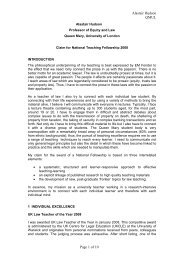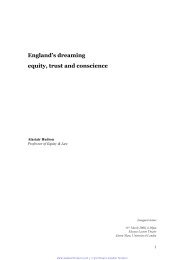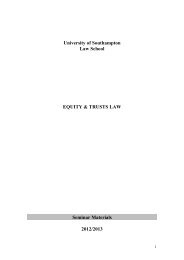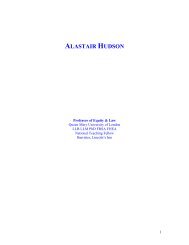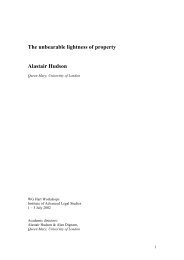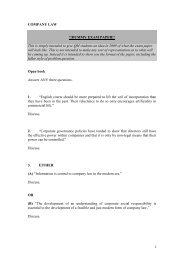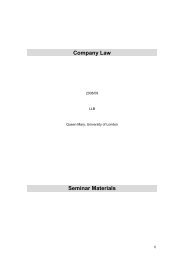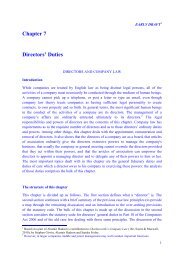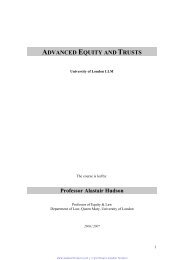Soton Equity and Trusts - alastairhudson.com
Soton Equity and Trusts - alastairhudson.com
Soton Equity and Trusts - alastairhudson.com
You also want an ePaper? Increase the reach of your titles
YUMPU automatically turns print PDFs into web optimized ePapers that Google loves.
(D)<br />
trusts.<br />
The proper constitution of trusts & the problem of in<strong>com</strong>pletely constituted<br />
General reading: Hudson, sections 5.4 <strong>and</strong> 5.6<br />
Question: What if the settlor promises to settle property on trust but fails to constitute the<br />
trust properly: can the intended beneficiary claim a right in conscience to the property?<br />
1) Methods for the proper constitution of a trust<br />
Reading: Hudson, section 5.4<br />
Milroy v. Lord (1862) 4 De G. F. & J. 264<br />
2) Imperfect gifts may not be effected by means of a trust …<br />
Reading: Hudson, sections 5.4.3<br />
**Milroy v. Lord (1862) 4 De G. F. & J. 264, per Turner LJ (there is no equity to perfect<br />
an imperfect gift):<br />
‘... in order to render a voluntary settlement valid <strong>and</strong> effectual, the settlor<br />
must have done everything which, according to the nature of the property<br />
<strong>com</strong>prised in the settlement, was necessary to be done in order to transfer<br />
the property [to the trustee] <strong>and</strong> render the settlement binding upon him. He<br />
may, of course, do this by actually transferring the property to the persons<br />
for whom he intends to provide, <strong>and</strong> the provision will then be effectual <strong>and</strong><br />
it will be equally effectual if he transfers the property to a trustee for the<br />
purposes of the settlement, or declares that he himself holds it in trust for<br />
those purposes … but in order to render the settlement binding, one or<br />
other of these modes must, as I underst<strong>and</strong> the law of this court, be<br />
resorted to, for there is no equity in this court to perfect an imperfect gift.’<br />
3) … except where transferor has does everything necessary for him to do to effect the<br />
transfer<br />
Reading: Hudson, section 5.4.4<br />
Re Rose [1949] Ch 78<br />
**Re Rose [1952] Ch. 499 (ineffective transfer of legal title to shares but equitable title held to<br />
pass because inequitable for transferor to seek to renege on the transfer).<br />
Cf. Re Fry [1946] Ch 312 (no agreement by Treasury, still transferor could not rely on having<br />
done everything necessary for him to do)<br />
4) A loosening of the Rose principle<br />
Reading: Hudson, section 5.4.4<br />
T Choithram International SA v Pagarani [2001] 1 WLR 1<br />
Pennington v Waine [2002] 1 WLR 2075<br />
5) The return of <strong>com</strong>mon sense<br />
Reading: Hudson, section 5.4.4<br />
*Kaye v Zeital [2010] EWCA Civ 159, [2010] 2 BCLC 1<br />
*Curtis v Pulbrook [2011] EWHC 167 (Ch), [2011] 1 BCLC 638, Briggs J, three<br />
ways to make the Rose principle work:<br />
“The first is where the donor has done everything necessary to enable the<br />
donee to enforce a beneficial claim without further assistance from the<br />
donor... The second is where some detrimental reliance by the donee upon<br />
an apparent although ineffective gift may so bind the conscience of the<br />
donor to justify the imposition of a constructive trust … The third is where<br />
by a benevolent construction an effective gift or implied declaration of trust<br />
may be teased out of the words used.”<br />
(E)<br />
A reminder: how is an effective declaration made by the settlor?<br />
Reading: Hudson, section 2.6, <strong>and</strong> especially 3.3<br />
These cases have already been considered in relation to certainty of intention.<br />
Jones v. Lock (1865) 1 Ch. App. 25 (no effective declaration).<br />
32


